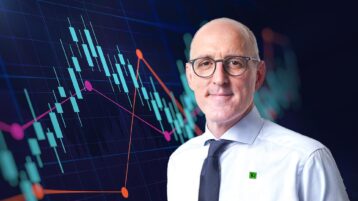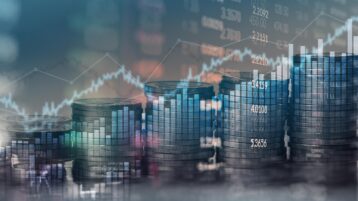Recent comments from U.S. Federal Reserve Chair Jerome Powell suggest interest rates could go higher than previously expected. But Scott Colbourne, Managing Director, Active Fixed Income at TD Asset Management, tells Greg Bonnell he still sees opportunity in fixed income.
Print Transcript
[AUDIO LOGO]
It has been a busy week for central bank officials. On Wednesday, the Bank of Canada kept rates on hold. Then you have Fed Chair Jerome Powell testifying before lawmakers in Washington that US rates could go even higher than previously expected to tame inflation. So what does it all mean for the fixed income markets?
Scott Colbourne, Managing Director of Active Fixed Income at TD Asset Management, our guest today, and joins us with more. Always great to have you here, Scott.
Greg, it's a pleasure to be here.
All right, so quite a week for people who discuss fixed income. And that's what we're talking about right now. All this central bank action, this divergence, what do we think of it all? Maybe we'll start with the US, because of course, they push the markets around a little bit more than the Bank of Canada does.
I guess we're in a data-dependent environment, right? And we're seeing slight divergence in that theme. So we start with the US and the Fed and Chair Powell's comments this week, basically introduced the optionality that maybe they even go 50 basis points at the next meeting.
And we got two key pieces of data, right? So the data-dependency focus, tomorrow we've got the nonfarm payrolls, and then next week we've got CPI. And so basically the Fed told us, look, the data is coming in a little bit stronger than we've expected.
We're going to probably-- we're going-- well, they're definitely going to be raising rates. It's just they're giving themselves the optionality, if the data comes in stronger, to reintroduce a pace that is greater than 25 basis points. And so that is describing that environment.
It really is an uncertain environment. So you step from the Fed. And then you look around the world, there is this uncertainty associated with where we are, with this inflationary environment that every country is dealing with. And do we--
In the Bank of Canada, we're on a conditional pause. And so it's conditional on the data evolving. And that is the uncertain world that we're all dealing with, whether as a policy maker or investors. And it is challenging for all of us to really navigate a narrow road, given the volatility and the uncertainty associated with this environment that we're in.
Heading into this year, there was investors that were sort of feeling a little bit more constructive, I guess the word would be, about the fixed income space, just like at some point, after the year we had last year and the aggressive rate hikes, these central banks are going to find that endpoint, that terminal rate. They might stay there for a while. But at some point because of this restrictive territory, they're going to start cutting. All of this should be good for fixed income.
I know we're only two months into the year and a little bit into the third month. But what are we thinking about fixed income, given what we're getting recently from all the central banks?
Generally speaking, we're constructive on fixed income. And we can sort of dive into that. But broadly speaking, I think, given the backup in yields, there are enough opportunities, whether it's across the yield curve or in sectors, to participate. And certainly from a longer perspective, given the post-GFC world that we've been in, we do have income for the first time in a long, long time, right?
So fixed income-- and that hasn't been available to us, given the fact that central bank policies have been so close to 0% for such a long time. So it is, generally speaking, a positive environment. That said, it's this-- the uncertainty associated with inflation-- and the history teaches us that rapid turnaround or the push from rapid rate hikes that we've had and the challenge that we had last year in 2022, to rapidly expect the pivot by the central banks this year.
And I think history teaches us that there's a lot more caution warranted from a policymaker point of view, that the risk for them is to err on the side of caution and stay tighter for longer. And so we begin the year. And they were rapidly pricing in rate cuts this year and then obviously a lot more into next year.
I think we're-- it's pretty clear that, given the trajectory of inflation, while coming down, has elements of stickiness in it, that there is a need to be patient from a policy maker's point of view.
And maybe even patient from an investment point of view. And you point out the fact that finally, you're actually getting a coupon. You're getting some yield on fixed income, that perhaps it makes sense that-- the idea when you're saying, being paid to wait. I've always found that an interesting thing as an investor. You're being paid to wait, because if you're in equities and you've got a dividend-paying stock, then you can be patient because you're getting those dividends.
But now we're actually getting some yield from fixed income as well. So if you need to be patient, at least the coupon's giving us something.
Yeah, I mean, you can-- the nice thing with fixed income is there is a mathematics behind it. And I don't want to go down into the weeds. But basically--
Get out the whiteboard.
Yeah, the mathematics.
[LAUGHTER]
I don't want to bore everybody. But generally speaking, there's-- you buy a two-year bond that's yielding 5%, say, in the US. You're going to get 5% for the year. You're paid 5%. Now, rates could go up more. But the income that you're getting is going to offset the decline that is associated with the increase in interest rates.
So it's not just the price of the bond moving up and down that is your return. It's the combination of the two. And with bond mathematics, you can sort of give yourself scenarios that-- are we at a breakeven point? So could rates go up 50 basis points?
And holding a 10-year bond right now, and you have a 0% return for the year? Yeah. So there's-- that's an important part of thinking through allocation to fixed income, in that income is an important part of that, sort of, if you will, scenario analysis in your portfolio.
Yeah, because last year, I think some of the frustration from people was-- and given the fact that the central banks were moving so aggressively, it didn't look great on the bond returns. And it didn't look great on the equity returns. So that idea of the 60-40 or 70-30 or how everyone wants to splice it up, they're starting to wonder if it worked anymore.
But the scenario you're laying at right now that, even if your breakeven part of at least that fixed income part of the portfolio is providing some sort of buffer?
Yeah, I mean, we went through a generational shock last year associated with policies that came out of a pandemic that we-- none of us had been through. And the impulse from monetary policy and fiscal policy caused a rapid increase in inflation. And policymakers had to respond. Equities and fixed income went through the one-- a long time in a generational shock--
And so now, we're transitioning from that rapid adjustment, higher in interest rates. And we're dealing with a stabilization, at least on fiscal policy. So we can expect a portfolio, a 60-40 portfolio, to play a role now, given the fact that fixed income has income.
And we talk about fixed income playing a few roles. Income is number one. Liquidity is important. So if-- you can rebalance that fixed income into equities or alts or whatever you want. But it's also diversification or your-- the role it plays to counterbalance. And so when days our equities are down, you're seeing a little bit more evidence that fixed income can balance that off in a 60-40 portfolio now.
[AUDIO LOGO]
It has been a busy week for central bank officials. On Wednesday, the Bank of Canada kept rates on hold. Then you have Fed Chair Jerome Powell testifying before lawmakers in Washington that US rates could go even higher than previously expected to tame inflation. So what does it all mean for the fixed income markets?
Scott Colbourne, Managing Director of Active Fixed Income at TD Asset Management, our guest today, and joins us with more. Always great to have you here, Scott.
Greg, it's a pleasure to be here.
All right, so quite a week for people who discuss fixed income. And that's what we're talking about right now. All this central bank action, this divergence, what do we think of it all? Maybe we'll start with the US, because of course, they push the markets around a little bit more than the Bank of Canada does.
I guess we're in a data-dependent environment, right? And we're seeing slight divergence in that theme. So we start with the US and the Fed and Chair Powell's comments this week, basically introduced the optionality that maybe they even go 50 basis points at the next meeting.
And we got two key pieces of data, right? So the data-dependency focus, tomorrow we've got the nonfarm payrolls, and then next week we've got CPI. And so basically the Fed told us, look, the data is coming in a little bit stronger than we've expected.
We're going to probably-- we're going-- well, they're definitely going to be raising rates. It's just they're giving themselves the optionality, if the data comes in stronger, to reintroduce a pace that is greater than 25 basis points. And so that is describing that environment.
It really is an uncertain environment. So you step from the Fed. And then you look around the world, there is this uncertainty associated with where we are, with this inflationary environment that every country is dealing with. And do we--
In the Bank of Canada, we're on a conditional pause. And so it's conditional on the data evolving. And that is the uncertain world that we're all dealing with, whether as a policy maker or investors. And it is challenging for all of us to really navigate a narrow road, given the volatility and the uncertainty associated with this environment that we're in.
Heading into this year, there was investors that were sort of feeling a little bit more constructive, I guess the word would be, about the fixed income space, just like at some point, after the year we had last year and the aggressive rate hikes, these central banks are going to find that endpoint, that terminal rate. They might stay there for a while. But at some point because of this restrictive territory, they're going to start cutting. All of this should be good for fixed income.
I know we're only two months into the year and a little bit into the third month. But what are we thinking about fixed income, given what we're getting recently from all the central banks?
Generally speaking, we're constructive on fixed income. And we can sort of dive into that. But broadly speaking, I think, given the backup in yields, there are enough opportunities, whether it's across the yield curve or in sectors, to participate. And certainly from a longer perspective, given the post-GFC world that we've been in, we do have income for the first time in a long, long time, right?
So fixed income-- and that hasn't been available to us, given the fact that central bank policies have been so close to 0% for such a long time. So it is, generally speaking, a positive environment. That said, it's this-- the uncertainty associated with inflation-- and the history teaches us that rapid turnaround or the push from rapid rate hikes that we've had and the challenge that we had last year in 2022, to rapidly expect the pivot by the central banks this year.
And I think history teaches us that there's a lot more caution warranted from a policymaker point of view, that the risk for them is to err on the side of caution and stay tighter for longer. And so we begin the year. And they were rapidly pricing in rate cuts this year and then obviously a lot more into next year.
I think we're-- it's pretty clear that, given the trajectory of inflation, while coming down, has elements of stickiness in it, that there is a need to be patient from a policy maker's point of view.
And maybe even patient from an investment point of view. And you point out the fact that finally, you're actually getting a coupon. You're getting some yield on fixed income, that perhaps it makes sense that-- the idea when you're saying, being paid to wait. I've always found that an interesting thing as an investor. You're being paid to wait, because if you're in equities and you've got a dividend-paying stock, then you can be patient because you're getting those dividends.
But now we're actually getting some yield from fixed income as well. So if you need to be patient, at least the coupon's giving us something.
Yeah, I mean, you can-- the nice thing with fixed income is there is a mathematics behind it. And I don't want to go down into the weeds. But basically--
Get out the whiteboard.
Yeah, the mathematics.
[LAUGHTER]
I don't want to bore everybody. But generally speaking, there's-- you buy a two-year bond that's yielding 5%, say, in the US. You're going to get 5% for the year. You're paid 5%. Now, rates could go up more. But the income that you're getting is going to offset the decline that is associated with the increase in interest rates.
So it's not just the price of the bond moving up and down that is your return. It's the combination of the two. And with bond mathematics, you can sort of give yourself scenarios that-- are we at a breakeven point? So could rates go up 50 basis points?
And holding a 10-year bond right now, and you have a 0% return for the year? Yeah. So there's-- that's an important part of thinking through allocation to fixed income, in that income is an important part of that, sort of, if you will, scenario analysis in your portfolio.
Yeah, because last year, I think some of the frustration from people was-- and given the fact that the central banks were moving so aggressively, it didn't look great on the bond returns. And it didn't look great on the equity returns. So that idea of the 60-40 or 70-30 or how everyone wants to splice it up, they're starting to wonder if it worked anymore.
But the scenario you're laying at right now that, even if your breakeven part of at least that fixed income part of the portfolio is providing some sort of buffer?
Yeah, I mean, we went through a generational shock last year associated with policies that came out of a pandemic that we-- none of us had been through. And the impulse from monetary policy and fiscal policy caused a rapid increase in inflation. And policymakers had to respond. Equities and fixed income went through the one-- a long time in a generational shock--
And so now, we're transitioning from that rapid adjustment, higher in interest rates. And we're dealing with a stabilization, at least on fiscal policy. So we can expect a portfolio, a 60-40 portfolio, to play a role now, given the fact that fixed income has income.
And we talk about fixed income playing a few roles. Income is number one. Liquidity is important. So if-- you can rebalance that fixed income into equities or alts or whatever you want. But it's also diversification or your-- the role it plays to counterbalance. And so when days our equities are down, you're seeing a little bit more evidence that fixed income can balance that off in a 60-40 portfolio now.
[AUDIO LOGO]



























